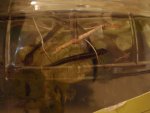I agree with Ryan, looks like it could be a Eurycea, but I'd need closer pictures to really figure it out.
IF they are Eurycea, they could possibly be...
Eurycea quadridigitata (Dwarf salamander)- this sp. has dorsolateral dark lines, but only 4 toes on the hind foot
Eurycea bislineata/cirrigera (Two lined salamander)- distinguish between these species based on where you are, otherwise they look so much alike, dorsolateral dark lines, 5 toes on hind feed
Eurycea guttolineata (3 lined salamander) - this sp. would have three dark lines (2 dorsolateral and 1 dorsal)...but I couldn't get a good view of the dorsal surface and I've not seen this sp.'s larvae
Eurycea wilderae (Blue ridge two lined salamander) - similar to other two lines, but sometimes the dorsolateral lines are broken into spots
Keep in mind that I've only had 1st hand experience with Eurycea cirrigera larvae. My suggestions are based off of the pattern seen in the pictures and what would have a similar pattern as an adult and be a Eurycea. This website has sketches of different larvae...
http://fisc.er.usgs.gov/c1258_Dodd/html/larvae.html
But if you type different species into goole with the word larvae, you'll likely turn up photos for comparison. Word of caution, not all photos are labled correctly, but I've found that photos submitted to Calphotos (
http://calphotos.berkeley.edu/) can be fairley reliable, and the benefit is that you get a few reviewers who will correct a mislabled photo. Another option is to search Caudata.org 's gallery for the species and see if that turns up any larval photos.
If you're going to keep the salamander larvae, you'll have to think about housing and food. Where did your student find them? A puddle? A flowing stream? The habitat they were found in can give you good tips on how to house them (flowing stream - use a good bubbler to create a soft current). Food will most likely be the most difficult challenge. My Eurycea larvae hunted prey on the bottom of the tank, and not at the surface. If you can get a daphnia culture started, they should accept that as food. But life will be a lot easier for you if you can get them to eat frozen foods (I used frozen bloodworms). The thing is that the larvae may be hunting using motion of their prey. To get my larva to eat bloodworms, I would put a few (4-6) in the water near the larva, and then use a small pipette to suck up water and expel it towards the bloodworms so that they gently floated/moved towards the larva. I'm not sure if the larva were attracted to them due to that movement, or do to the smell. Remove uneaten food. Some will say to remove it 30 minutes after initial feeding, but I found that my larva needed more time to get over the fact that a giagantic human was bustling around its tank before it was comfortable enough to eat. Oh, if the tadpoles are small enough (i.e. part of them could fit in the sal's mouth) they will likely eat them. Hope this was helpful, I'm a beginner to, but this site has great advice and you can pick up a lot from it and other reputable websites. Good luck!




